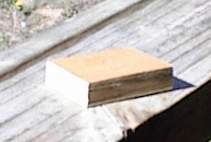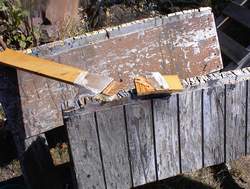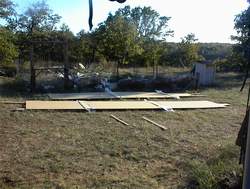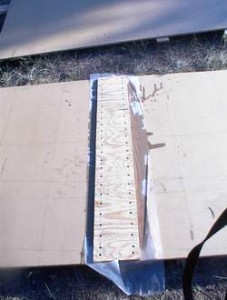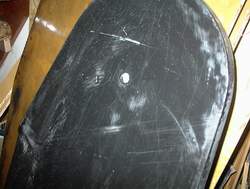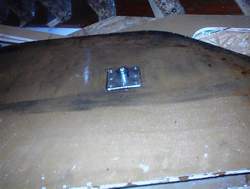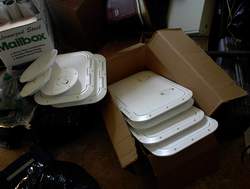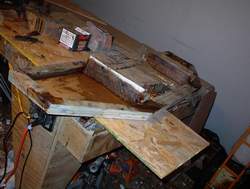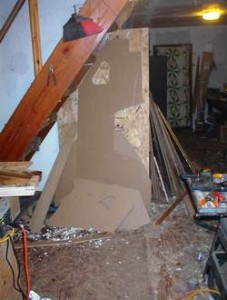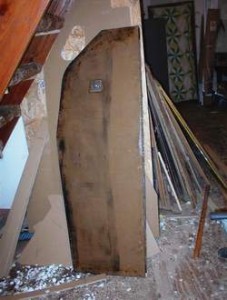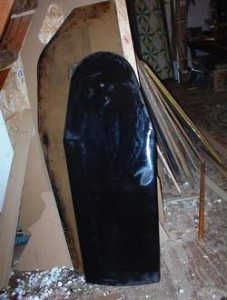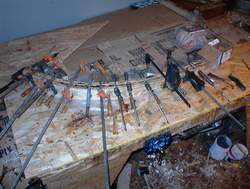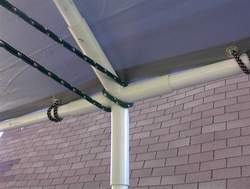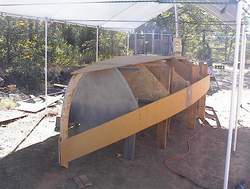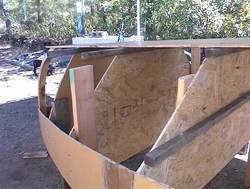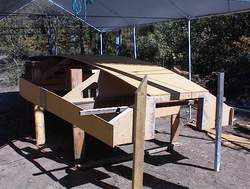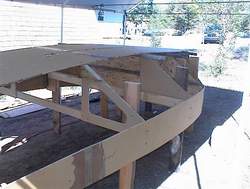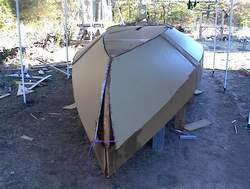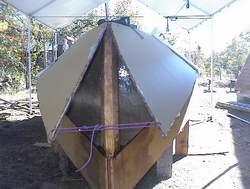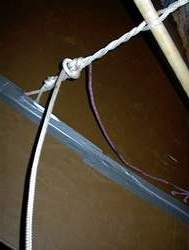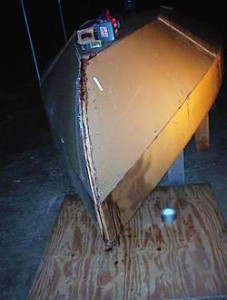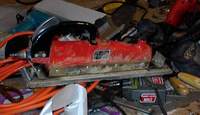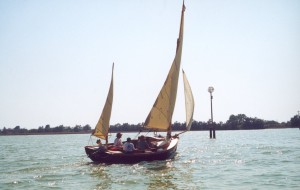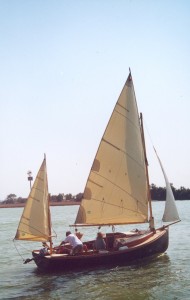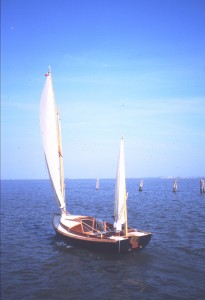Building the CLC.
Here are a couple of pictures of the making of the 24X8 panels for cutting the topside out. There is a backing block of 1/2″ ply behind the joint, which the clamping block you see screws into. I’m using wax paper to keep the epoxy from sticking to the boards. This is problematic, it sometimes gets glued very good to the epoxy, and takes a wire brush on a drill to separate! Sometimes, though, it pulls right off. Go figure. Will be using polyethylene from now on, it doesn’t stick at all. My garden is in the background, where I grow cardboard boxes.
***
Hi Richard
Just got back from the Port Townsend Wooden Boat Festival in Port Townsend,
(where else?) Washington. This year, for the first time, a Chebacco was in
the show.
Jerome McIlvanie has done an absolutely beautiful job on his lapstrake
version (see Chebacco News 28, October 1999.) Both the boat and finish are
immaculate, and the varnished hatch and cabin doors (doors, not drop
boards!) are the icing on the cake. I wish I could send you a picture, but
I didn’t think to take one – too dazzled, I guess! John Kohnen was there,
though, with camera in hand, so maybe he would forward one for the Chebacco
page, if asked. Maybe Jerome will send in a write-up on his building
experiences as well, it would be very worth-while.
Wayward Lass was in Port Townsend again, but she was down in the “other”
marina. We’ve had a lot of small craft warnings, and Friday was no
exception, but the strong winds (up to 25 knots) weren’t expected until the
afternoon. When I left the dock at 6:05 am, there was no wind at all, and
there wasn’t enough to make sailing worthwhile until 7:30. Once the sails
were up, I left the motor going in order to cross before the small craft
warning came to pass. I’ve never motorsailed before, it’s always been one
or the other – but it worked well, with the speed over 6 knots most of the
time.
My new Garmin 12 GPS keeps me on track as well as giving me the exact speed
over the bottom. It told me the tide sweeping down between the San Juan and
Canadian Gulf Islands was pushing me over 20 degrees off course, and made
adjusting for this a breeze. It also provided added peace of mind when the
early morning fog advanced to meet me in the middle of the Strait, dropping
visibility to a couple of hundred yards. These handheld GPS units are great
little helpers — I had my compass course, and expected the fog to lift
shortly anyway (it did), but still….
I rounded Point Wilson, 2 miles north of Port Townsend, at 11:40, and shut
down the motor. I had a great sail down to Point Hudson, where the town is,
pulling ahead of a bigger boat, who was still motoring (their main was up,
but sheeted right in, while the wind was behind us.) Once around Point
Hudson, I sailed close past the entrance to the Festival at the Point Hudson
Marina, and on down the shore between all kinds of boats, both anchored and
sailing around. Decided it was too good to stop, so I gybed and went back
to Point Hudson for another go round.
Saturday was the day the BolgerList guys were to meet. We mostly got
together at the CLC booth (met John Harris of CLC there), then moved over to
the café for cinnamon buns – but they didn’t have any this year! Tragedy!
Still, we managed. Those present were John Kohnen, Derek Waters, John
Ewing, myself, and Miles, whose last name I didn’t get – sorry, Miles.
Afterwards, we went down to see Jerome’s boat, and found Alan Woodbury
there, with his father in law, Roger.
Did the docks then – my favourites were Jerome’s Chebacco (we need a name
there, Jerome) and a Lyle Hess Renegade, the design that Serrafyn was built
to, I believe.
We met up again at Wayward Lass about 1:30, and went for a sail – John,
John, Alan, Roger and myself. (Derek had his family, and Miles was off to
hike the Olympic Mountains with his wife.) Alan took the helm and we headed
out past Point Hudson, then over to watch the schooner race. We had a good
view of the start, then followed the race down to the first buoy. On the
return leg, we saw Jerome on the water and sailed over to say “Hi”. The
wind had about dropped by then, and he was just taking down his sail as we
approached. Still looked great, though.
We also saw a Martha Jane, owned by Bennett from California – the boat’s
name was Steadfast. She looked good, and Bennett told us he’s sailed her
all over, including Florida and the East Coast. Although we were going in
similar directions from time to time, we didn’t get into a head to head
race, so we can still both hold to our conviction that our boat is superior!
I will say, though, that the lug sail looked very impressive.
That was about it for boat showing. Jerome, Alan, John Kohnen and myself
had dinner together at the little café by the Boat Haven – good fish and
chips and great milkshakes! After that we went our separate ways. I was
worrying about the weather for the next day, so I tuned in to the weather
channel on VHF. It sounded like the forecast was improving, but it was
still expected to blow hard again in the afternoon – and in the morning I
could expect to lose 2 knots to the tide. Gradually the conviction grew
that the best time to head home was right then, even though it would take
most of the night, and I still had some stuff I wanted to do first.
Anyway, I left the dock at 10:30, with my battery operated nav. lights
duct-taped to the masts. Even before I reached Point Hudson I was getting a
lift from the tide – 6 knots at half throttle. I rounded Point Wilson at
10:55, and 20 minutes later I was making 8.7 knots over the bottom! (Normal
motoring speed is about 5.5 knots.) It was almost a windless trip, except
for a bit of breeze in the Point Wilson area, so I didn’t have the sails up
at all. It was chilly, I was glad of the Mustang Cruiser suit, with hat and
gloves on as well. After the fog on the way over, I had bought a radar
reflector in Port Townsend, and I was glad of it as I passed three big
freighters in the dark. I saw the lights of each in the distance, but
couldn’t tell what they were until they were about a quarter of a mile away,
when they suddenly materialized out of the gloom and became these huge
ships.
I reached the Customs dock in Victoria’s Inner Harbour at 4:18 in the
morning, called in, then got my head down for a couple of hours before
making breakfast and heading to Fleming Beach and the launch ramp. A great
night’s trip to end a great weekend. If I’ve missed anyone or mispelled
their name, I apologize. See you all again next year.
***
Hi Richard,
here are some pictures of our newborn
chebacco “Kitty Hawk”.
Cheers,
Vincenzo
Hi Richard,
thanks for you nice message. I made the wooden blocks out of black locust
using drawings on “the rigger apprentice” by B. Toss as templates.
The tabernacle has worked well, so far. As I had mentioned, I did not like
the original turnbuckle system to hold the mast, and replaced it with a
steel fence-like piece (I will try to take a picture of it).
Yes I did leave room for the gaff between boom and the folded mast and, just
like you plan to do, I keep the boat under a tarp with the sail and rigging
attached with the mast folded down.
The sails were made by a professional sailmaker (veleria Zadro in Trieste)
that is one of the few in this country to know how to cut a gaff sail. Thanx
for your suggestions about the sails. I will try to increase the draft on
the main by playing with the halliards and the boom out haul, and see if that
improves things. Zadro refused to cut the mizzen dead flat! Any way I am now
trimming it flatter than it looked in those early pictures. I am also
experimenting the mizzen with a conventional boom instead of the sprit.
The aft hatches are made as in the plans and they seem to be good enough to
keep rain and spray out; of course some water would get in case of capsize
or if swamped by a big wave.
I will try to send you details of the blocks and tabernacle.
Yes, things around the back of the cockpit and the motor/slop well are
indeed a bit different than in the plans. I will send you pictures of the
details. Anyway, the idea was to make the cockpit self-baling when the water
reaches the level of the seats; So there is an oval cut at that level in the
back of the cockpit that drains in the slop well that has the round drainage
holes that you noticed. These holes serve the double purpose of keeping
things in the slop well and of accepting some rubber flaps (not yet on in
the picture!) mounted on the stern that would act as valves. The flaps are
needed only to prevent BIG waves coming from astern from spilling water in
the well (and in the cockpit!) while letting water go in the opposite
direction. At some point I will have to do some sort of swamp test to verify
all this!
Ciao,
Vincenzo.
***
When I came to Tulsa for flight school I owned a 14′ O’day Javelin sailboat. I
brought it along. On October 31st, 1987 my roommate and I decided to go
sailing. It was in the 80’s, which was un seasonal for that time of year. The
water, however was pretty cold. He had never been sailing. I had sailed a
little, but no formal lessons.Background: The last time I sailed in Ohio before coming to OK it was a wild
time. A highschool buddy and I took the boat up to the lake. When we got there
a big thunderstorm was approaching the lake, and all other boats were leaving.
We looked at each other and said “What the F***”. We put the boat in the water
and rigged it. By the time we had the sail up it was raining cats & dogs. We
started out of the boat launch and the gale force winds hit. Man did we have
the time of our lives! The bow was cutting through the waves like we were at
sea! She was hiked over and water was running into the cockpit area from the
low side. Water was POURING from the mainsail onto us. It was an awesome time!
(I/we didn’t realize how STUPID that was!)Back to OK… My roommate and I got the boat out onto Keystone with no
problems. We had sailed around for about an hour. Then we noticed a storm
developing to the south. (Little side note here… an Ohio storm does not
equal an Oklahoma storm .. unknown to us..) I announce “Hey, no it’s gonna get
fun!” LOL!!! Boy was THAT an understatement!!! The winds were so strong out of
the south that I reefed the mainsail quite a bit, and dropped the jib
altogether. I was getting frightened. (Did I mention that I swim like a
ROCK!?) I started back towards the boat launch, but of course it was to the
south. Directly into the wind. My buddy (who had never sailed before) kept
telling me to put the sails all back up and lets have fun. I finally listened
to him. We started tacking back and forth to get to the boat launch.It was on the third or fourth tack when the wind shifted drastically and with
great force. It grabbed the mainsail and “jibbed” it. (It took it from one
extreme to the opposite side all at once — and fast!) The momentum took the
boat right over. We capsized in a heartbeat.Both of us clammered up on the bottom of the boat. At first it was funny. We
were laughing. Then I heard her taking on water. The lifejackets were neatly
stowed in the cuddy cabin. Nice, eh? I tried swimming under and getting them,
but my feet keep getting tangled in the rigging. (Did I mention that I swim
like a ROCK!? LOL!!) It had “full floatation”, but it had taken on so much
water that we were unable to keep it “righted” each time we tried.At the time of capsizing we were only a couple hundred feet from the launch.
By this time the wind and current had blown us out into the middle of the
lake! (Did I mention that I swim.. Oh yeah..never mind) All day long we had
not seen ONE person on the lake. My buddy made a very brave move, which I
still appreciate to this day. He decided to swim for shore from the middle of
the lake! It was horrible to watch. Each time his head would go below a swell
in the water, I thought he had drown! I was standing on the bottom of my boat
yelling for him all the way! I know he couldn’t hear me with the wind, but I
had to do something. It seemed like he swam forever. When he finally made it
ashore, he was dead tired. He waved to me. Then he limped up the hill and out
of site looking for help.Ok.. now it gets funny. After my friend’s ordeal.. this Bayliner with 4 dudes
partying goes by! I scream.. they come over and I get on their boat. I tell
them to let my sailboat sink because I don’t care anymore! They were great
about it and lashed it, still capsized, to their Bayliner. When we got to the
launch I notice that it had banged the side of their boat up pretty bad. I
don’t think they noticed since they were so stoned. LOL! My buddy finally
comes back over the hill and I am standing by my car! LOL!! Poor guy!Final side note. After getting it onto the trailer I could not pull it until
enough water drained out to get the trailer fenders up off the tires. It took
2+ hours to drain! LOL!!That night we treated ourselves to a steak dinner. We had our picture taken
with our waitress. I still have that photo, and the memories. What a great
friend!Ok.. I’m all mushy now. 🙂
That’s my Keystone story.
Keith

